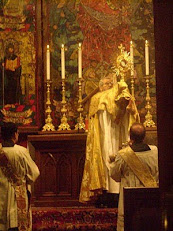The Counter Reformation and Anglican Patrimony
I have given one subject quite an amount of thought, that of defining Anglican patrimony in relation with the Counter Reformation patrimony in Catholicism. It seems to me that this point has been narrowly missed in our postings and threads of comments, but never really addressed head-on.
The Counter-Reformation was the Catholic Church’s answer to the scourge of Protestantism, the loss of parts of Europe to the Church, and also to its own corruptions and problems in the clergy in the late middle-ages. It was therefore defined by the Protestantism challenging the Catholic world, and less by the early pre-decadent medieval tradition...
Read the rest of his thoughtful contribution to this discussion at The Anglo-Catholic blog.














No comments:
Post a Comment